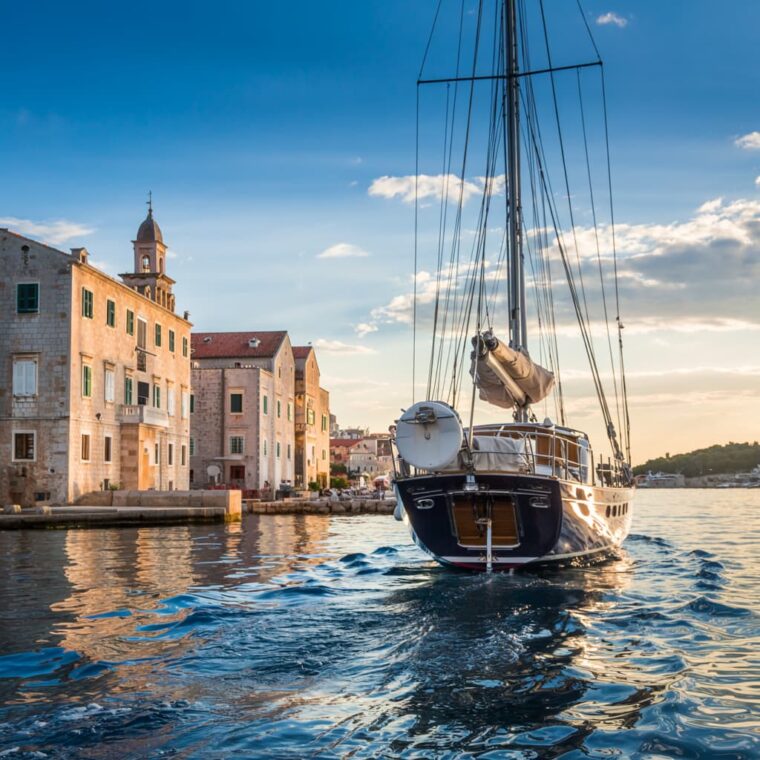- Diverse Sailing Destinations: Croatia’s extensive coastline and 1,200+ islands offer a variety of experiences, from historic UNESCO sites and ancient towns to secluded anchorages and vibrant nightlife. The region’s mix of natural beauty and rich cultural heritage makes it ideal for both first-time sailors and seasoned adventurers.
- Comprehensive Charter Guide: The post details step-by-step instructions on how to charter a yacht, including choosing the right type of boat, understanding legal requirements, and navigating contractual details. It provides clear insights on services, seasonal trends, and safety tips to ensure a seamless and memorable trip.
- Practical Sailing Tips: Essential advice includes monitoring Croatia’s local wind patterns like the Maestral, Bura, and Jugo, budgeting for additional costs such as fuel and mooring fees, and packing smart for limited onboard space. These practical tips help travelers prepare effectively and enjoy a safe, comfortable Mediterranean sailing adventure.
KEY TAKEAWAYS
Introduction
Chartering a yacht in Croatia is no longer a secret known only to experienced sailors. It’s fast becoming one of Europe’s most sought-after maritime getaways, blending crystal-clear waters, ancient towns, and over a thousand islands into the perfect sailing holiday. This guide is designed to show you exactly how to charter a yacht in Croatia—whether you’re new to sailing or a seasoned skipper chasing your next adventure.
Croatia’s Adriatic coastline stretches more than 5,800 kilometers and offers access to 1,200+ islands, each with its own charm. You’ll discover unspoiled anchorages, UNESCO World Heritage sites, and lively harbors all within a few nautical miles of each other. The country’s rich maritime heritage, dating back to the Roman and Venetian periods, adds a unique historical layer to every itinerary.
From the dramatic limestone cliffs of Kornati to the lavender-scented hills of Hvar, this corner of the Mediterranean offers diversity unmatched in Europe. Thanks to reliable summer winds like the Maestral, calm seas, and modern marinas, sailing here feels effortless.
Whether you’re interested in skippered yacht rentals or bareboat charters, this guide will walk you through each step of how to charter a yacht in Croatia, making it simple, rewarding, and unforgettable.
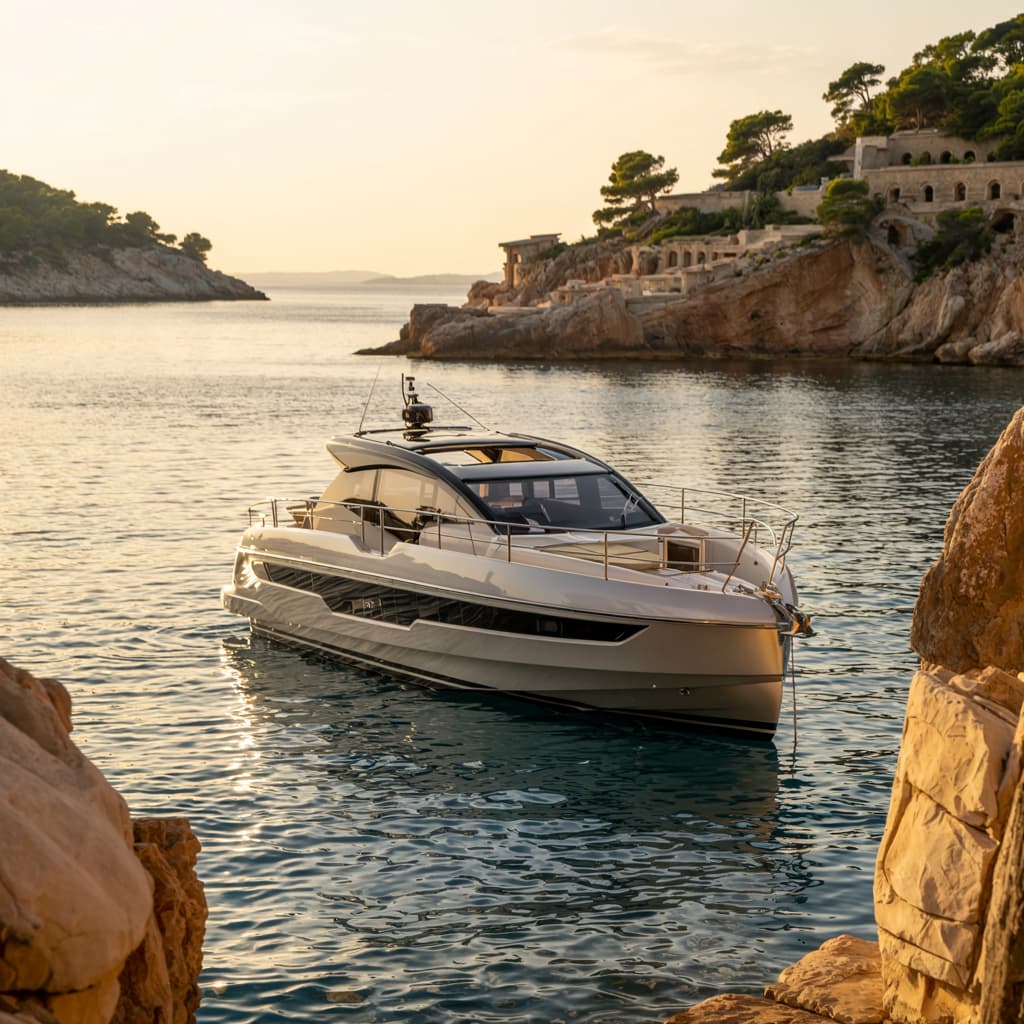
Why Choose Croatia for Yacht Chartering
Croatia’s 5,800 kilometers of coastline and more than 1,200 islands make it one of the most intricate coastal landscapes in Europe. This expansive shoreline offers countless private coves, sheltered bays, historic ports, and family-friendly beaches—all within reach during a single charter. Islands like Brač, Vis, and Hvar are just a few among many that cater to sailors of every experience level.
The Dalmatian Islands provide some of the Adriatic’s most scenic sailing experiences, while the Kornati archipelago—with over 140 uninhabited islands—forms the Kornati National Park, a protected maritime area famed for its stark limestone cliffs and exceptional diving spots. To the north, the Istria Peninsula offers Venetian-influenced coastal towns blending Renaissance architecture and gourmet cuisine.
Croatia’s Mediterranean climate makes yacht chartering ideal from May to September. During these months, the average sea temperature ranges between 21°C and 27°C. The Maestral wind, a steady northwesterly thermal breeze, provides favorable conditions for smooth and safe sailing, especially in the afternoons. Meanwhile, sailors should understand local wind systems like the Bura (a dry, cold wind from the northeast) and the Jugo (a warm, humid wind from the southeast), which may affect navigation.
For travelers seeking both natural beauty and cultural richness, Croatia offers UNESCO World Heritage sites such as Dubrovnik’s medieval walls and Split’s Diocletian’s Palace. Korčula, often dubbed “Little Dubrovnik,” and Hvar with its 13th-century fort, offer deep-rooted history and vibrant nightlife.
With its rich maritime heritage, diverse sailing routes, and hospitable marinas, this Croatia yacht guide shows why yachting here isn’t just a trip—it’s a journey through time, nature, and culture. For first-time visitors, mastering yacht rental tips in Croatia ensures a rewarding and safe voyage.
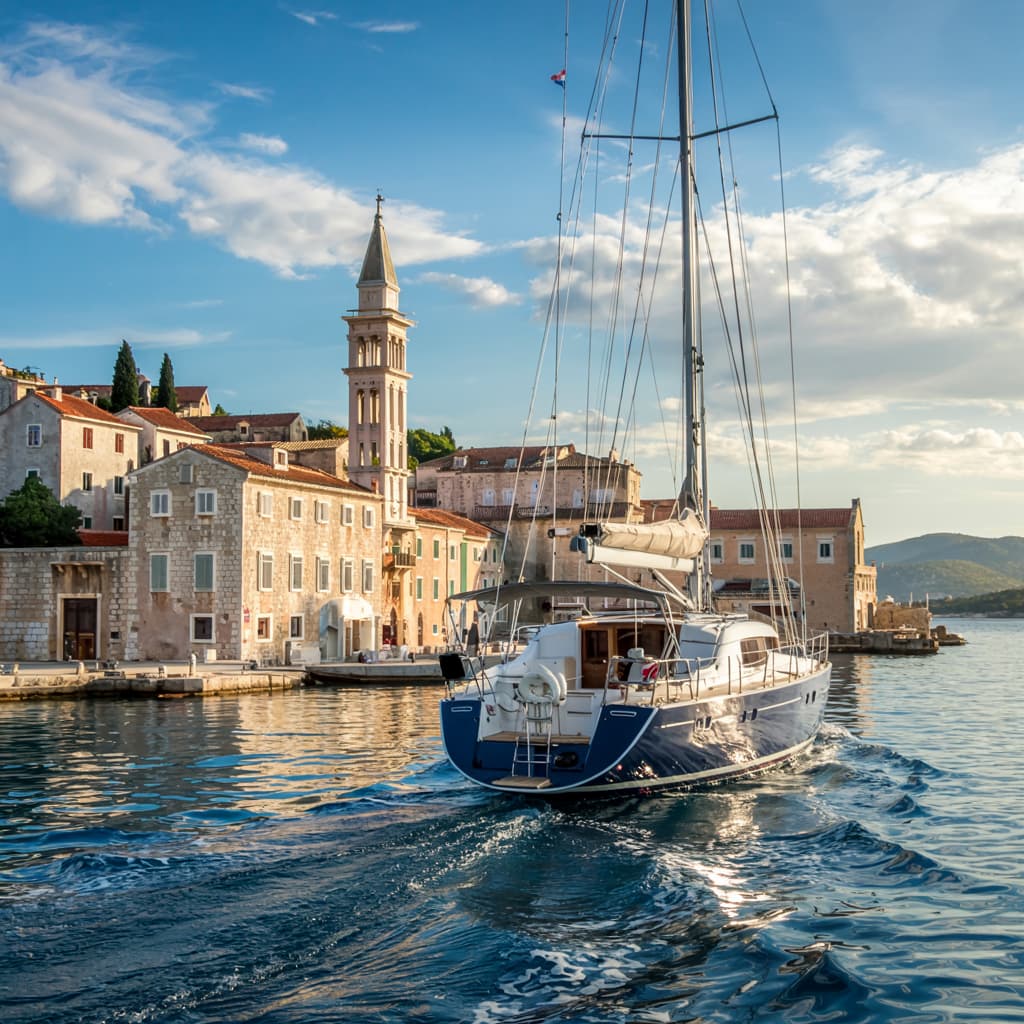
Comprehensive Croatia Yacht Guide
Top Yacht Destinations Along the Dalmatian Coast
Among Croatia’s 1,200 islands, a few locations consistently stand out for sailors. Dubrovnik, a UNESCO World Heritage Site, draws attention with its medieval walls, baroque architecture, and proximity to the Elafiti Islands. For a more modern escape, Split offers Roman history, including the Diocletian’s Palace, and bustling marinas like ACI Marina Split. From here, many travelers chart courses to island gems.
Hvar, known as the “St. Tropez of the Adriatic,” blends luxury, lavender fields, 13th-century fortresses, and electrifying nightlife. Sailors often dock in Hvar Town or explore quieter coves like Dubovica Beach. Korčula, the reputed birthplace of Marco Polo, showcases Venetian architecture and centuries-old vineyards, ideal for history and wine lovers. Nearby Mljet stuns visitors with its national park, featuring two saltwater lakes and a 12th-century Benedictine monastery on St. Mary Island.
For nature-rich escapes, head north. Šibenik provides access to Krka National Park’s waterfalls and Gothic-Renaissance cathedrals. Further offshore lies the Kornati archipelago—a string of over 140 uninhabited islands and reefs forming Kornati National Park, a sailor’s paradise known for crystal waters and lunar-like scenery.
Popular Yacht Routes in Croatia
A well-loved 7-day itinerary travels from Dubrovnik to Split. This south-to-north route covers 170 nautical miles, featuring must-stops like the Odyssean Cave on Mljet, scenic anchorages in Lastovo, Hvar nightlife, and historical tours in Korčula. The route ends with delightful beaches and Diocletian-era culture in Split.
For a circular adventure, opt for the Split–Vis–Hvar–Brač loop. This 140-nautical-mile trek touches Vis, home to the famed Blue Cave on Biševo Island and unique beach enclaves like Stiniva Cove. Brač entices with the iconic Zlatni Rat beach near Bol, ideal for windsurfing and paddleboarding.
Longer voyages might include the Central Adriatic’s tranquil Kornati National Park. Routes from Zadar or Šibenik often cover Dugi Otok, Telašćica Nature Park, and secluded bays like Levrnaka. Each of these stops provides moorings in natural harbors and chances to savor fresh seafood in konobas (traditional taverns).
See Yacht Charter Croatia options.
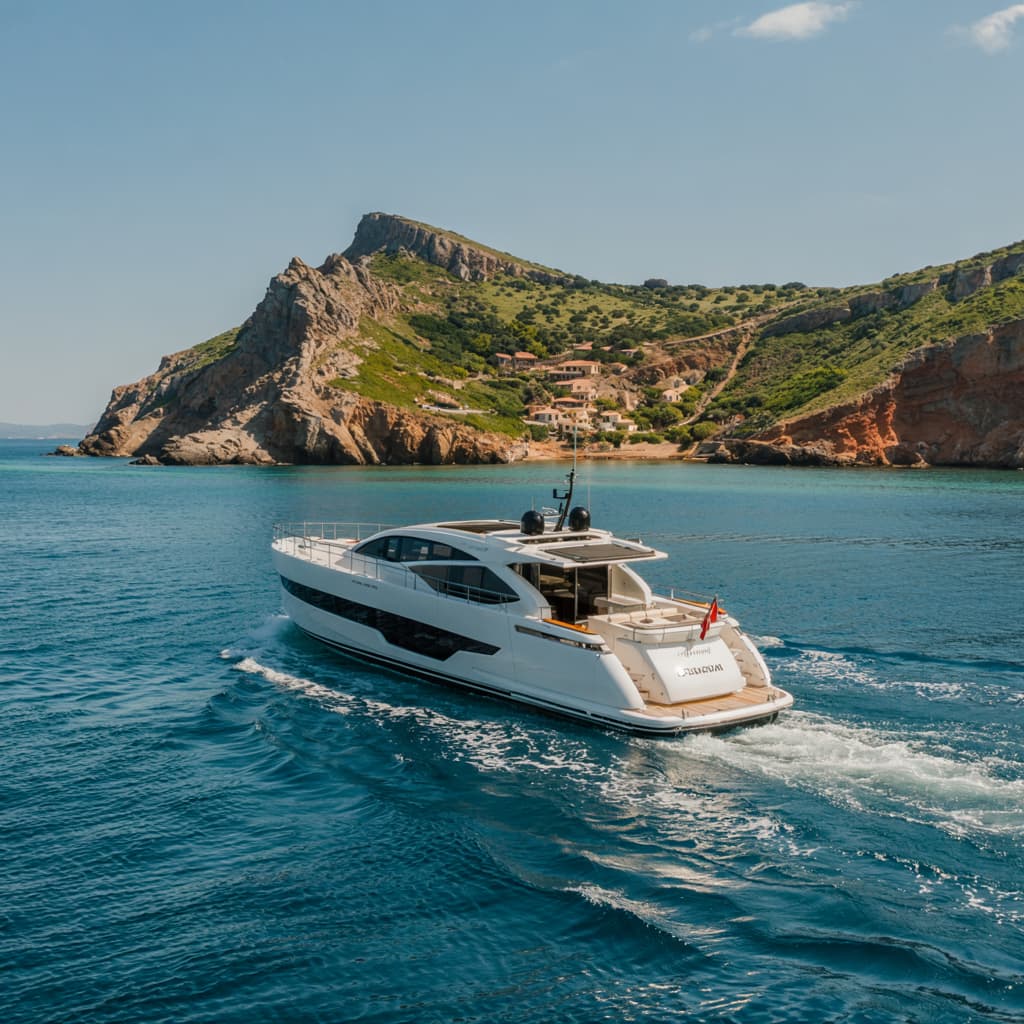
Weather and Wind Patterns for Sailing
Croatia’s sailing season peaks between June to August, when the Adriatic experiences more than 10 hours of sunlight per day and water temperatures reach 25°C. May and September offer fewer tourists, milder temperatures (averaging 20–24°C), and lower mooring fees—ideal for those seeking relaxed charters.
Experienced skippers closely monitor the Adriatic’s wind systems. The Maestral is a reliable summer afternoon wind from the northwest. It supports smooth sailing along the coastline and commonly picks up after midday, subsiding before dusk. The Bura, a dry and cold northeasterly, can create sudden and strong gusts—especially near Velebit Mountain—and warrants caution.
Alternatively, the Jugo is a warm, humid wind arriving from the southeast. It can bring rain and longer swells, especially during shoulder seasons. Charterers should plan their routes around these variations, using local weather stations and maritime forecasts for daily updates.
These insights are critical components of any Croatia yacht guide and support smart planning. Paying close attention to weather specifics, local geography, and seasonal factors provides a smoother and safer trip. One of the most useful yacht rental tips Croatia travelers can follow is to align their route with current wind patterns to ensure comfort, safety, and fuel efficiency.
How to Charter a Yacht in Croatia
Step 1: Research Reputable Charter Companies
Begin by investigating established yacht charter providers operating along the Croatian coast. Look for companies that are legally registered with the Croatian Chamber of Economy and hold valid tour operator licenses. Ensure the fleet is well-maintained, insured, and receives regular safety inspections. Reading verified customer reviews and checking affiliations with industry associations like CYBA (Charter Yacht Brokers Association) or MYBA (Worldwide Yachting Association) adds another layer of security. Avoid brokers or intermediaries with unclear pricing or hidden fees. Reliable booking platforms such as viravira.co offer large inventories and verified suppliers for transparent bookings.
Step 2: Choose the Right Type of Yacht
Understanding the various yacht types is crucial when learning how to charter a yacht in Croatia. Monohull sailboats are classic options for purist sailors. They are agile and perform well in Croatia’s variable wind conditions. Catamarans, with their double-hull design, offer more stability and spacious living areas—ideal for families or groups. Motor yachts provide faster travel and luxury onboard amenities, making them popular for island-hopping along the Dalmatian coast.
Decide between a bareboat, skippered, or crewed charter. A bareboat charter requires at least one qualified skipper onboard, with a valid nautical license (typically RYA Day Skipper or Croatian Category B license) and VHF Radio Certificate. Skippered charters include a professional captain to handle navigation—ideal if you lack experience. A crewed charter includes additional staff like a chef or steward, ensuring a luxury cruising experience from Split to Hvar or Kornati National Park.
Step 3: Understand Contracts and Costs
Thoroughly examine the yacht rental agreement before confirming your booking. Pay attention to the payment schedule—most companies request a 50% deposit upon booking and the balance 4–6 weeks before departure. Review cancellation policies carefully. Some operators offer partial refunds depending on the notice period, while others may provide only credit or rescheduling options.
Charter prices usually include the yacht rental itself but exclude items like fuel, mooring fees, end-cleaning, and provisioning. Fuel costs vary based on usage. For motor yachts, expect 4–6 liters per nautical mile. Mooring fees range between €30 and €120 per night, depending on the marina and boat size. Provisioning can be arranged in advance via a “provisioning list” service or bought locally in port towns like Trogir or Šibenik.
Step 4: Legal Requirements and Documentation
Croatian maritime law mandates that bareboat charterers hold an ICC (International Certificate of Competence) or a national license recognized by Croatian authorities. A VHF radio license is also required to operate on the water. You can check accepted licenses at the official website of Croatia’s Ministry of the Sea, Transport and Infrastructure (Source).
Having insurance is essential. Most yachts come with hull and third-party liability insurance, but consider buying trip cancellation or personal accident coverage as well. Always carry physical and digital copies of your charter contract, passport, proof of skipper qualification, and insurance documents.
Knowing these steps not only simplifies how to charter a yacht in Croatia but also ensures a seamless experience from planning to boarding. Whether you’re sailing through the Elaphiti Islands or exploring secluded bays near Vis, being prepared keeps your focus where it belongs—on the Adriatic.
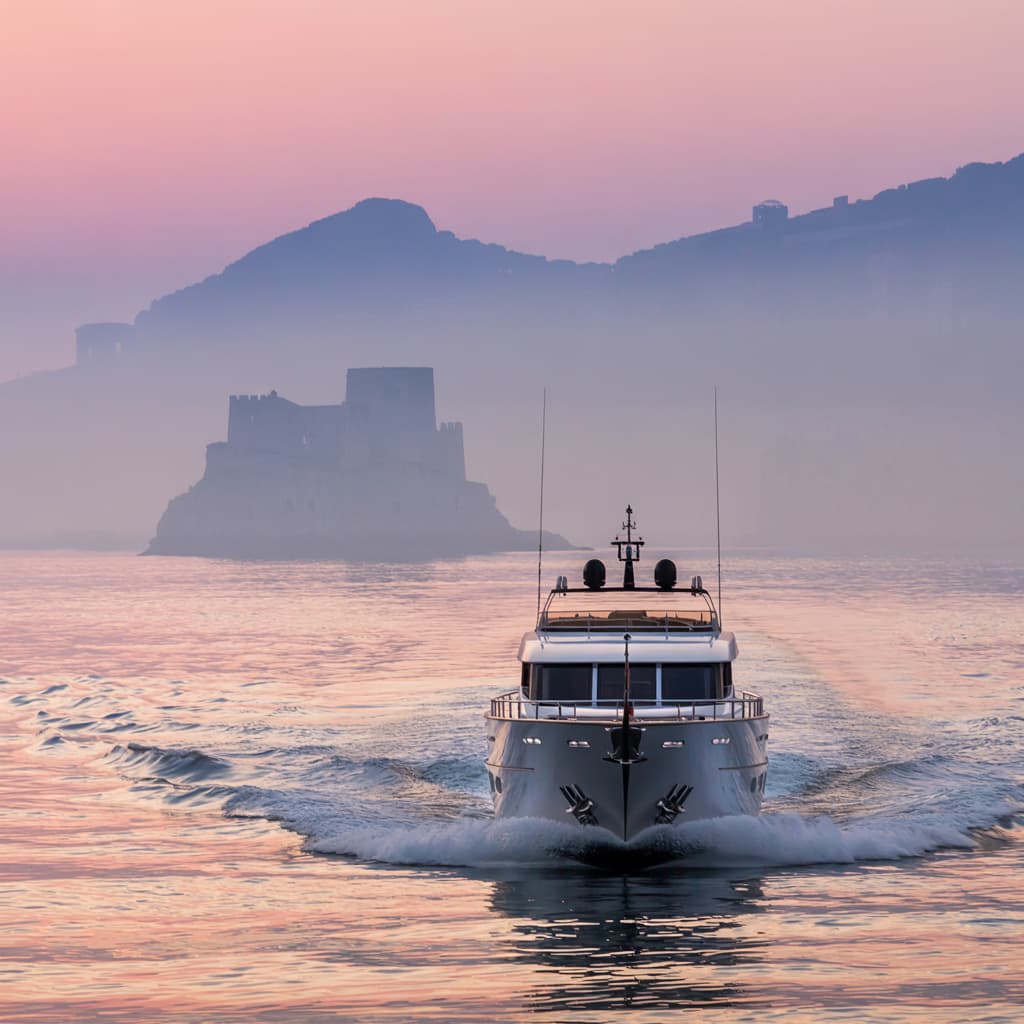
Yacht Rental Tips Croatia
Choose the Right Yacht Based on Group Size & Charter Type
Picking the right vessel is one of the most important yacht rental tips Croatia visitors must consider. The size of your group determines whether a monohull sailboat, catamaran, or motor yacht will suit you best. Catamarans offer more stability and space, making them ideal for families and groups of 4 to 8. Monohulls provide a classic sailing experience, often preferred by seasoned sailors. For larger groups or luxury seekers, motor yachts provide top-tier comfort and speed.
Next, decide between a crewed or bareboat charter. If no one in your group has a valid ICC (International Certificate of Competence) or similar license, a skippered or crewed option is mandatory. Bareboat charters offer autonomy for licensed sailors with prior yachting experience. Crewed options include at least a skipper, and may also offer a chef or hostess, ideal for indulgent, stress-free cruising.
Understanding the True Costs of Yacht Chartering
When planning your Croatian sailing holiday, it’s essential to go beyond the base charter fee. Base prices for a 40-foot bareboat sailing yacht range from €1,500 per week in May to €5,000+ in August. A crewed luxury motor yacht can reach €30,000–€70,000+ weekly in high season.
You also need to budget for:
• Fuel: A sailboat may use €100–€300/week; motor yachts significantly more depending on distance and consumption.
• Mooring and docking: Marina fees vary by port and vessel size. ACI Marina Split charges around €100/night for a 40-foot boat in summer.
• Provisions: Whether provisioning yourself or through a service, expect to spend €150–€300 per person per week.
• Tourist tax: Usually around €1.33 per person per day.
• Security deposit or damage waiver: Ranges from €1,000–€3,000 refundable, or €200–€400 non-refundable waiver.
Understand seasonal price fluctuations. June to August is peak season with the best weather, but also the highest rates. May, September, and early October offer lower prices and fewer crowds while still enjoying warm conditions.
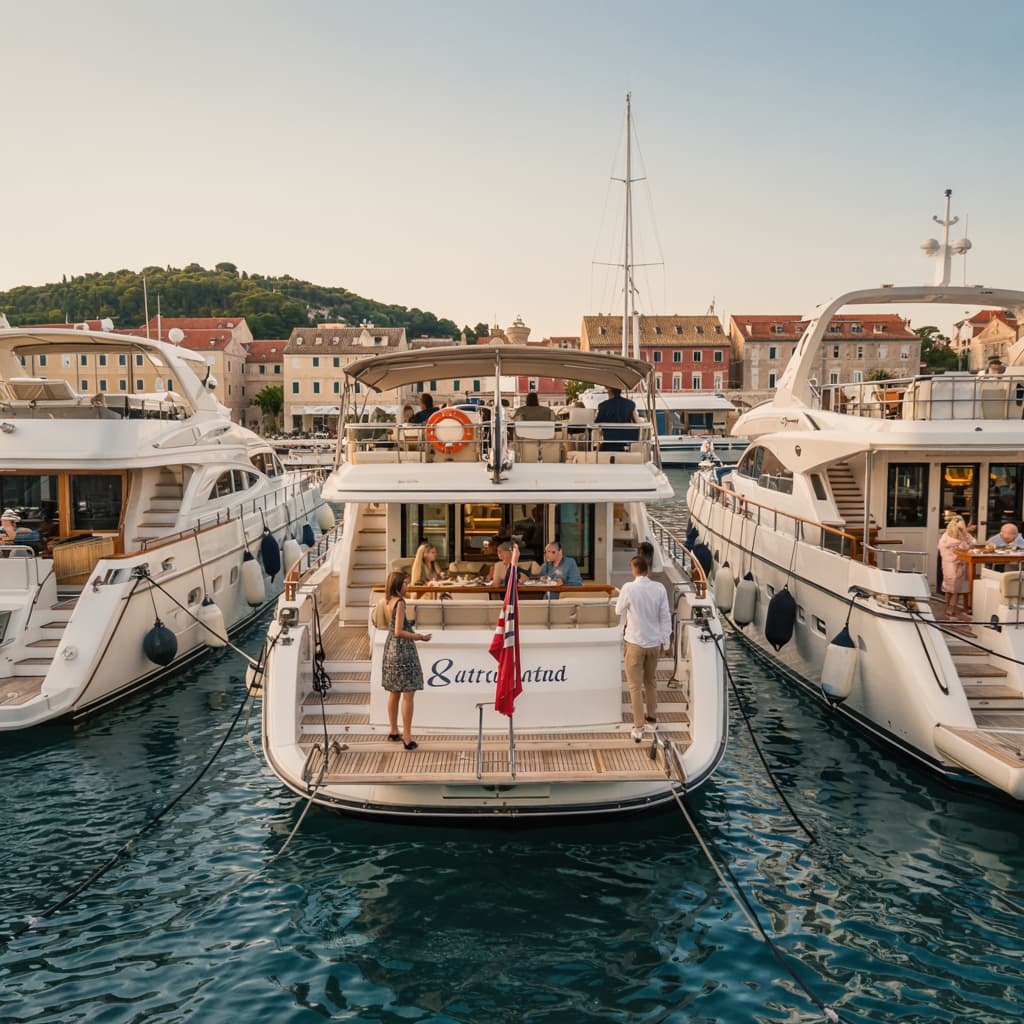
What to Pack for a Croatian Yacht Adventure
Be strategic when packing. Space on yachts is limited, so soft bags are easier to stow than hard suitcases. Pack lightweight clothing, swimsuits, and layers for breezy evenings. Avoid dark-soled shoes; choose non-skid deck shoes or sandals with grip.
Don’t forget essentials like high-SPF sunscreen, polarized sunglasses, a wide-brimmed hat, and motion sickness remedies. A dry bag, waterproof phone pouch, and reef-safe toiletries are also helpful. Bring USB chargers and power banks, as outlets may be limited.
Onboard Etiquette and Safety Tips
Follow basic sailing etiquette to maintain harmony and safety. Always listen to the skipper, secure loose items on deck, and respect quiet hours if sharing marinas. Do not flush anything other than biodegradable marine toilet paper in marine toilets.
Respect marine life—avoid anchoring on seagrass meadows, do not touch sea creatures, and refrain from using plastic products that can blow overboard. Croatia is home to dolphins, sea turtles, and fragile coral ecosystems.
Local Insights: Ports, Cuisine and Activities
Popular departure ports include ACI Marina Split, known for modern amenities, and Marina Kornati in Biograd, a gateway to the Kornati National Park archipelago. Other scenic stops include Hvar, Vis, and Mljet Island.
Croatian cuisine offers a symphony of Mediterranean flavors. Must-try dishes include Black Risotto (Crni Rižot) made from cuttlefish ink, and slow-cooked Peka, traditionally baked under a metal bell with veal or octopus. Pair meals with local wines such as Plavac Mali or Pošip.
Top activities include snorkeling in Stiniva Cove, diving in shipwreck sites like Vis, and vineyard tours on Korčula Island. These cultural and natural experiences enrich any Croatia yacht guide, offering more than just scenic sailing routes.
Yachting in Croatia is not just about sailing—it’s about exploring hidden bays, eating regional delicacies, and connecting with the Adriatic. Following these yacht rental tips Croatia has to offer can transform your trip into an unforgettable nautical adventure.
Additional Resources
For official tourism data, maps, and regional sailing routes, visit the Croatian National Tourist Board. It provides up-to-date information on marinas, nautical regulations, and seasonal events—vital for planning your itinerary. Additionally, refer to comprehensive sailing references like the Yacht Charter in Croatia Guide for details on prevailing winds, anchorage points, and sailing permits.
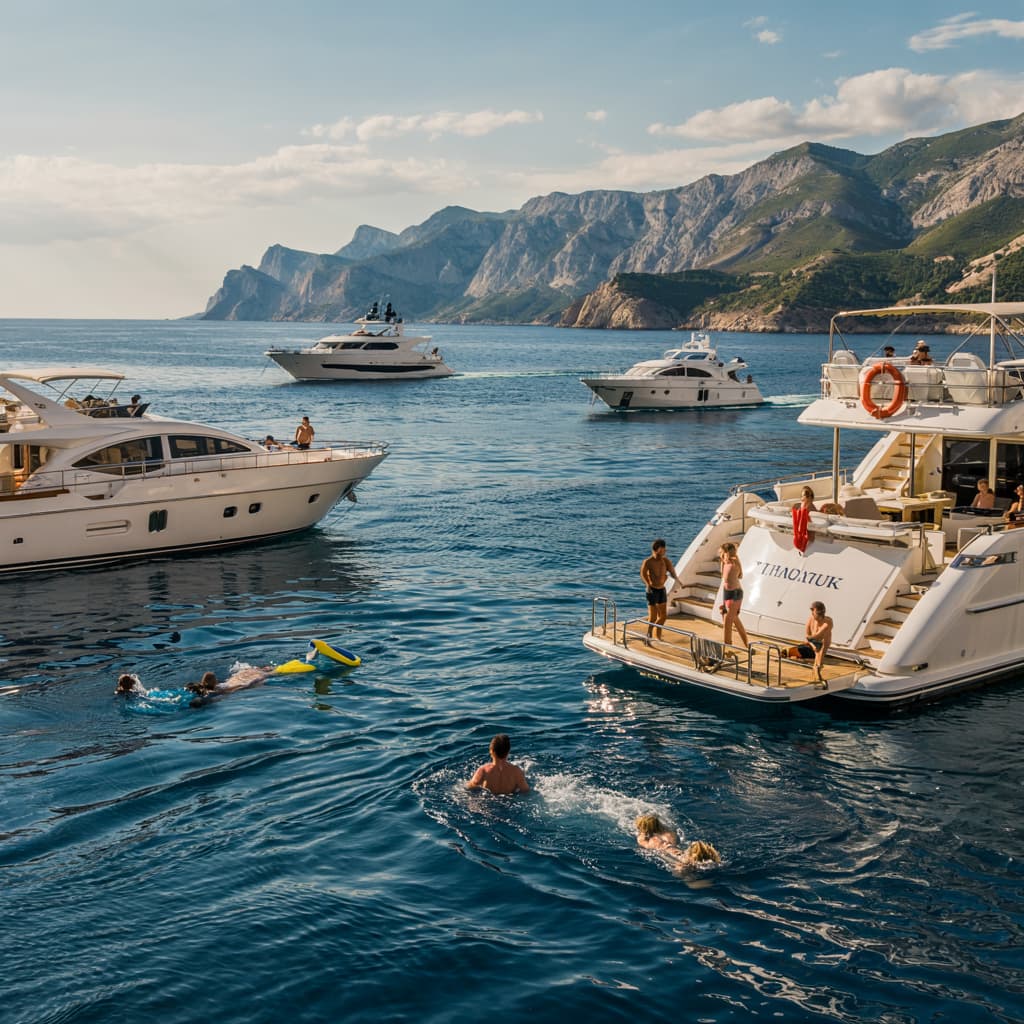
Before finalizing any booking, always verify charter company qualifications, safety certifications, and insurance coverage. These resources complement your yacht rental tips for Croatia, helping you navigate legal and logistical considerations efficiently.
Conclusion
Learning how to charter a yacht in Croatia begins with choosing the right boat for your adventure. Whether you prefer a bareboat charter for full independence or a crewed luxury yacht for unrivaled comfort, the vessel should match your group size, sailing experience, and travel goals. Consider catamarans for stability or sailing yachts for a more traditional feel.
Next, understand Croatia’s legal requirements. For bareboat charters, at least one person must hold a recognized skipper license and VHF radio certificate. These must be approved by the Croatian Ministry of Maritime Affairs, Transport and Infrastructure. Most charter companies can assist with verifying these documents in advance.
Then, plan your itinerary carefully. From the medieval charm of Dubrovnik and the lavender-rich island of Hvar to the UNESCO-listed city of Trogir and the hidden coves of Vis, the Dalmatian Coast offers a stunning mix of natural beauty and rich heritage. Croatia’s 1,000+ islands promise secluded anchorages, vibrant marinas, and clear Adriatic waters ideal for snorkeling, paddleboarding, or sunbathing.
Exploring the Adriatic by yacht offers a one-of-a-kind way to experience Croatia. Contact a trusted charter provider to customize your route, ensure safety and comfort, and start your journey toward unforgettable island-hopping adventures.
| Category | Details |
| Destination | Croatia – Enjoy over 5,800 km of Adriatic coastline and 1,200+ islands. |
| Best Time to Charter | May to September; peak season is June to August for optimal weather and winds. |
| Yacht Types & Charter Options | • Bareboat (for qualified skippers with ICC/Croatian license) • Skippered charters • Crewed luxury yachts • Options include monohulls, catamarans, and motor yachts |
| Popular Destinations & Routes | • Dalmatian Coast: Dubrovnik, Split, Hvar, Korčula, Mljet • Itineraries: 7-day Dubrovnik to Split, Split–Vis–Hvar–Brač loop, Central Adriatic (Kornati National Park) |
| Weather & Wind Patterns | • Reliable summer Maestral wind (northwest) for smooth sailing • Local winds include the Bura (cold gusts) and Jugo (warm, humid conditions) • Average sea temperatures: 21°C–27°C during summer |
| Legal & Safety Requirements | • Valid skipper qualifications (ICC or recognized national license) • VHF radio certificate required • Mandatory insurance (hull and third-party liability; optional trip cancellation/personal accident) |
| Cost Factors | • Base charter fees vary (e.g., 40-foot bareboat from approx. €1,500/week in May to €5,000+ in August) • Additional costs: fuel, mooring fees (typically €30–€120/night), provisions, tourist tax, and security deposit/damage waiver |
| Local Insights & Activities | • Explore UNESCO heritage sites (Dubrovnik, Split, Trogir) • Enjoy local cuisine such as Black Risotto and Peka • Engage in water sports, snorkeling, diving, and island-hopping adventures |
| Booking & Trusted Resources | • Research reputable charter companies from viravira.co • Verify licenses, insurance, and customer reviews • Use official Croatian tourism sources for up-to-date marina info and sailing routes |
FAQs
To start chartering a yacht in Croatia, research reputable charter companies that are legally registered and offer well-maintained fleets. Ensure they have proper licenses and industry affiliations. Verify customer reviews and choose companies that provide transparent pricing without hidden fees.
The ideal yacht type depends on your group size and preferences. Monohull sailboats offer a classic sailing experience, while catamarans provide stability and space for families. Motor yachts are great for luxury and speed. Consider crewed options if you lack a sailing license.
Chartering a yacht in Croatia involves not just the base fee, but also additional costs like fuel (€100–€300 for sailboats, more for motor yachts), mooring fees (€30–€120/night), provisioning (€150–€300 per person/week), tourist tax (€1.33 per person/day), and a security deposit.
The ideal time for yacht chartering in Croatia is from May to September. During this period, the Mediterranean climate offers favorable sailing conditions with sea temperatures between 21°C and 27°C. Peak season (June-August) has higher prices, but May and September offer milder climates and fewer crowds.
For a bareboat charter in Croatia, you need an ICC (International Certificate of Competence) or a national license recognized by Croatian authorities, along with a VHF radio license. Ensure you have insurance documentation and your charter contract readily available.
Popular routes include a 7-day journey from Dubrovnik to Split covering 170 nautical miles with stops in Mljet, Lastovo, Hvar, and Korčula. Another option is the Split–Vis–Hvar–Brač loop, which encompasses the Blue Cave, Stiniva Cove, and Zlatni Rat beach.
Safety measures include understanding local wind patterns like the Maestral, Bura, and Jugo. Always listen to the skipper for navigation advice, secure items during sailing, and follow ecological practices to protect marine life. Ensure your charter company offers hull and third-party liability insurance.

